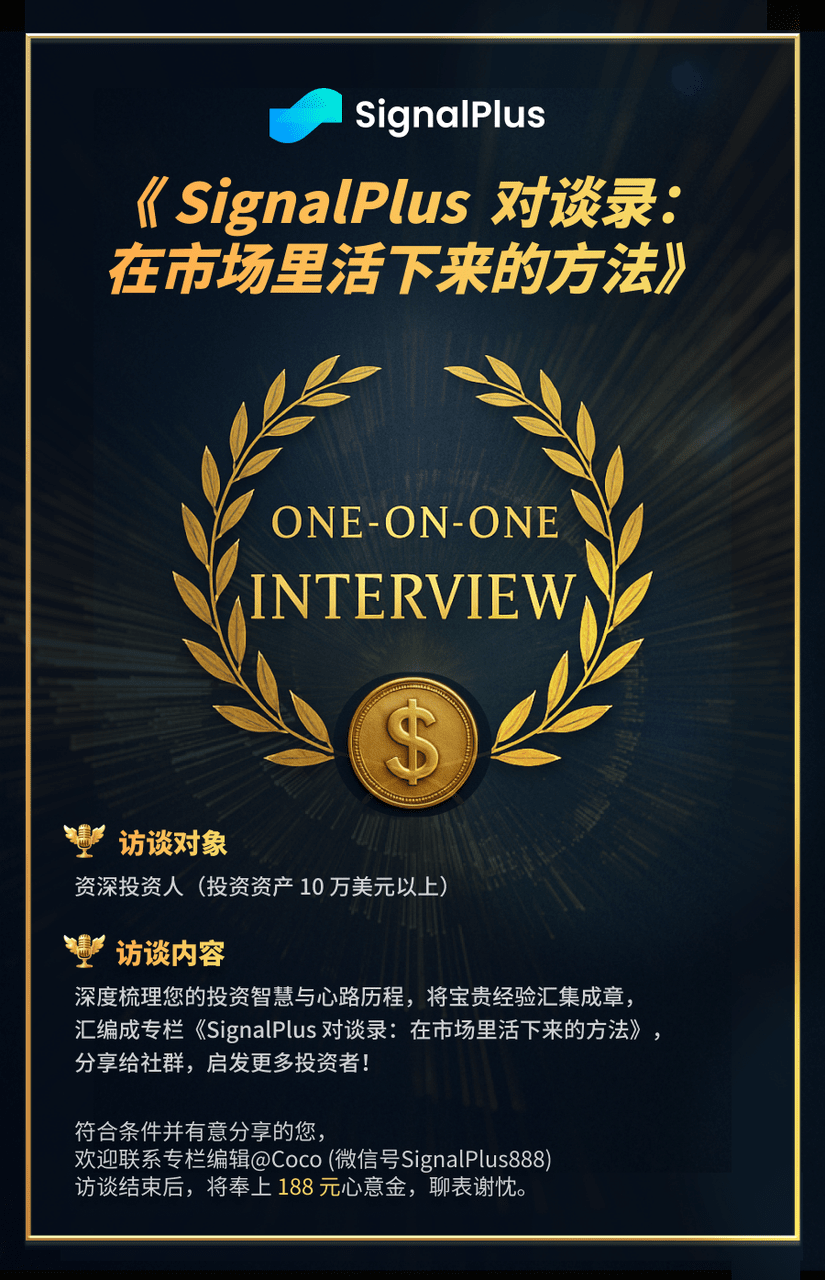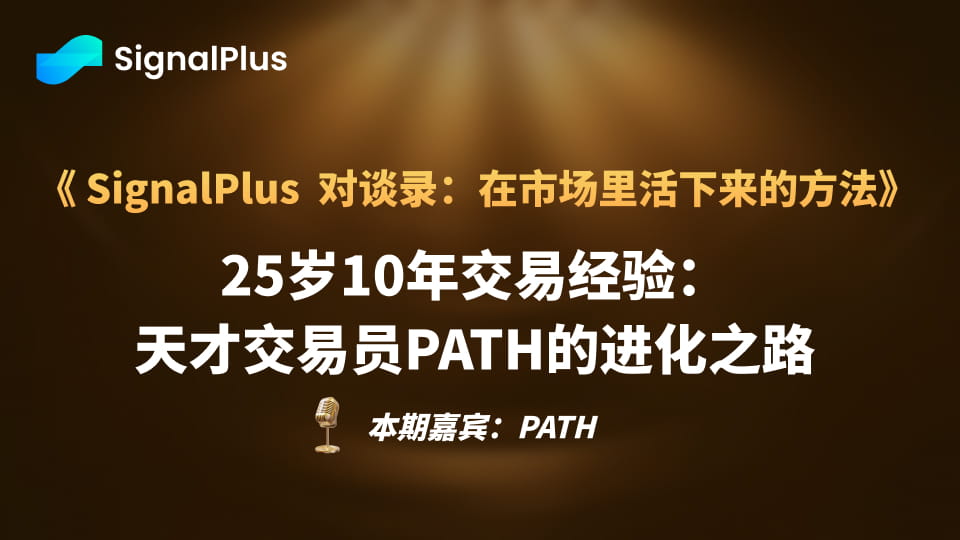
Introduction
At the age of 15, when he was still finishing junior high school, Path experienced his first stock market crash.
Most people might not master the essence of trading even after ten years. But this 25-year-old, newly graduated young man, spent ten years cultivating himself into a trading actuary who regards "survival" as his first creed.
Last year, his investment in Bitcoin's "Black Swan Lottery" netted him hundreds of thousands of dollars. Behind this success was an extremely sophisticated trading strategy. And behind this strategy was a trading philosophy called "ergodicity."
In his eyes, trading is no longer a life-or-death adventure, but a daily cost management game. His goal is clear and focused: by continuously "burning costs," he aims to keep holding costs approaching zero or even negative, ultimately ensuring he can reap the rewards of uncertainty, regardless of market fluctuations.
In this episode (SignalPlus Big Player Dialogue), Path unreservedly demonstrated for the first time the core logic of its cross-market arbitrage and how it uses options strategies to create "free lottery tickets" to build a low-cost "anti-fragile" system.
If you are willing to give up the fantasy of getting rich overnight, please join us on this long journey to review the past ten years of trading.
Entering the stock market at 15 years old, the circuit breaker stock market crash is the first lesson
SignalPlus: Please introduce yourself first, PATH student, and tell us about your experience.
Path: I have about ten years of investment experience. I've worked with stocks, bonds, and derivatives like options and futures, and I have practical trading experience in all of them.
SignalPlus: Can I ask how old you are? I remember you just graduated. How did you get started in investing?
Path: I was born in 1999 and am 25 years old this year. I entered the market about ten years ago, a year before the A-share market crash. My first trading market was the A-share market because Alipay had just launched a simulated stock trading feature. I tried it a few times and thought it could be profitable, so I borrowed 10,000 yuan from a family member's account to start trading. However, at the beginning of the following year, I was fully invested when the stock market crash hit, which taught me a profound lesson. That was my first trading experience.
Survive to get rich: Ergodic thinking beyond black swans
SignalPlus: With ten years of experience, you should have gone through many cycles. Have you formed your own core concepts or preferred operating methods?
Path: The thing that I feel most deeply now is actually very simple: survive.
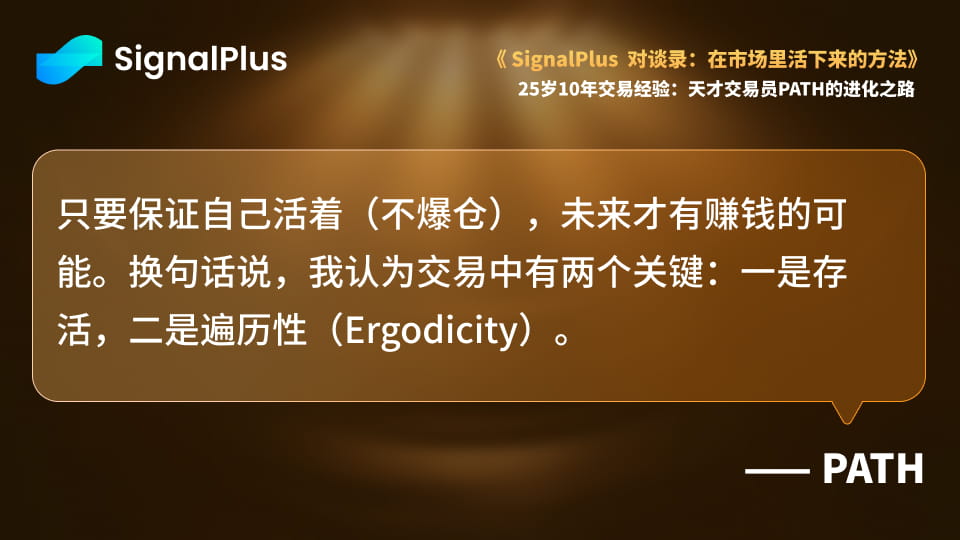
As long as you stay alive (and avoid a margin call), you have a chance of making money in the future. In other words, I believe there are two keys to trading: survival and ergodicity.
What is ergodicity? Simply put, given enough time, both good and bad things will happen to you sooner or later. Bad ergodicity means you'll eventually encounter extreme risk and end up losing your account; good ergodicity means you might one day hit a big opportunity and become rich overnight.
Whether good or bad, these extremes exist in the market because of its fat-tail nature and the unpredictability of black swan events. For example, didn't an old wallet holding 80,000 bitcoins suddenly become active a few days ago? This is actually a case of sudden wealth caused by "ergodicity."
Of course, he could never have predicted that the price of Bitcoin would reach $110,000 over a decade ago; otherwise, he wouldn't have bought just 80,000. This example demonstrates that good ergodicity (good luck) does exist. Similarly, anyone who aggressively invests heavily will sooner or later encounter bad ergodicity (bad luck) and be forced to exit the market.
How can you minimize bad ergodicity and increase your chances of good fortune? The key is staying alive—ensuring your presence in the market. If you survive long enough, for a long enough period, the effects of ergodicity will inevitably manifest, and your turn will always come. This is the point I've learned most profoundly so far.
SignalPlus: In mathematics, ergodicity generally refers to the probability of experiencing all possible scenarios over a sufficiently long period of time. Could you explain in layman's terms what you understand by "ergodicity" in trading?
Path: As long as it is possible to happen, it will definitely happen in the near future, and in the financial market, this future will often happen much earlier than expected.
One example is that in a market crash caused by deleveraging, due to the self-fulfilling nature of the market, highly leveraged traders are forced to close their positions, driving prices down further, and causing traders with slightly lower leverage to also fall into the forced liquidation range. This cycle continues, which may be accompanied by a liquidity vacuum such as circuit breakers, and the magnetic effect of circuit breakers, causing many traders to think that their leverage ratios are "very safe" and become the driving force behind their margin calls.
Some backtesting data may indicate that the probability of a portfolio triggering forced liquidation at a certain leverage ratio is less than 1%, but the market has a fat-tail distribution and self-fulfilling characteristics.
A similar case is LTCM's bankruptcy due to a Russian government bond default. LTCM's model estimated a Russian default to be an event seven or eight standard deviations away. According to the model, such an event might not occur once in a million years. But we all know what happened next.
SignalPlus: In order to deal with ergodicity, we need to consider various extreme scenarios as much as possible, right?
Path: To deal with traversability, we should make traversability work in our favor.
The market's fat-tail distribution and self-fulfilling nature are both objective facts, and we can use these facts to construct an investment portfolio. When the market reaches its tail, the impact on the portfolio should be positive, not negative. This is where nonlinear tools such as options come in.
The market is unpredictable, and there is no need to predict it. It is beneficial for me to always maintain a traversal attitude, and with the accumulation of time, I can get good results.
The first experience of making big money
SignalPlus: Do you remember the first time you made a significant amount of money?
Path: The transaction that made the most money for me was completed on BTC, which was during the market trend last year.
SignalPlus: Can you tell us the magnitude?
Path: Well, probably a few hundred thousand dollars.
SignalPlus: How much is the approximate capital invested?
Path: The principal was about $100,000, if I remember correctly.
SignalPlus: How did you make this money?
Path: It was mainly two-fold. On the one hand, I held spot positions to ensure I didn't sell them easily (and thus "lose" my coins) as the price continued to rise. During that period, my options positions were actually quite small. On the other hand, later, when the price of the cryptocurrency fluctuated at a high level, I began to explore some options strategies. The period that made me the most money was the market decline triggered by the drastic deleveraging in August of last year.
SignalPlus: Did you buy an out-of-the-money OTM Put at that time?
Path: Yes, I had already increased my options positions before that period, bought a lot of OTM Puts, and then used short-term options continuously in the short term to recover the cost of Long Puts.
SignalPlus: When you are holding positions or brushing costs, have you ever encountered particularly painful moments?
Path: Not really with BTC, but with other commodities. For example, the Shanghai Composite 50 Index fell sharply at the beginning of last year, but a small rally after the Spring Festival finally allowed me to recoup my investment and make a profit. With A-shares, they always fall, with only rare surges. If you're trying to cover your investment costs, your position will continue to increase. I even used some margin financing at the time, which actually goes against the ergodic principle I mentioned. If the market had continued to fall, I would have been wiped out.
Arbitrage opportunities are always hidden in the rules
SignalPlus: You just talked about A-shares, Crypto, and now using IBKR to trade US stocks. How did you build such a comprehensive investment system?
Path: First and foremost, it was out of curiosity. I'm truly interested in all kinds of financial markets. I started trading A-shares, and I was a complete novice at the time—I couldn't read financial reports, and I couldn't understand technical indicators. I'd hear people discuss things like MACD and KDJ, and even reading and researching was completely baffling. The more I learned, the more confused I became. Eventually, I gave up on direct stock trading and started learning about over-the-counter funds.
Through investing in mutual funds, I gradually learned how indices are constructed, how constituent stocks and weightings influence fund performance, index compilation rules, market capitalization weighting algorithms, and more. After understanding these basic principles, I turned my attention to studying exchange-traded fund (ETF) trading: how ETF quote matching works, the mechanisms of call auctions and continuous bidding, and so on.
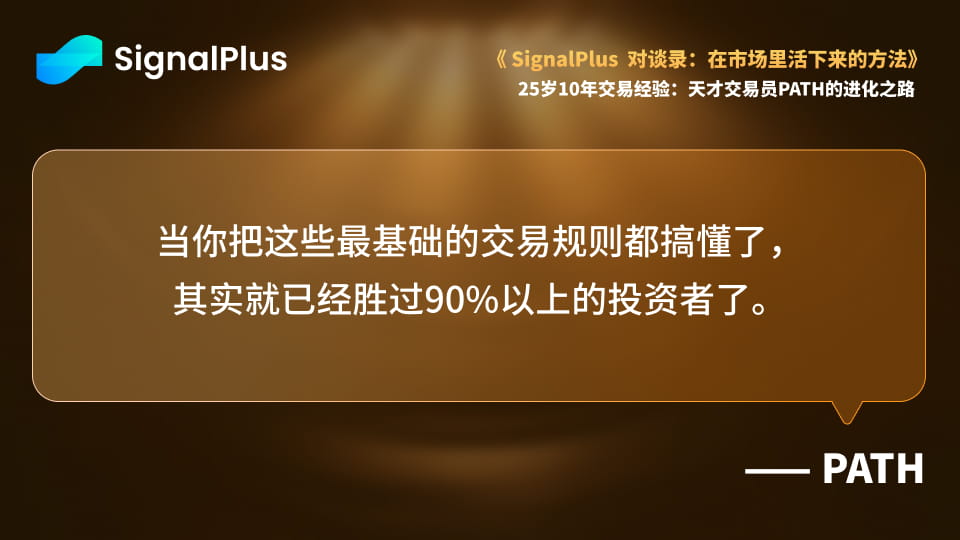
I've always had this philosophy: once you understand these most basic trading rules, you've already outperformed over 90% of investors. This understanding came from talking to many investors and gathering information from online forums.
In reality, many people don't even understand the most basic trading rules. Yet, many trading opportunities lie within these fundamentals. For example, in the Porsche-Volkswagen acquisition several years ago, CSRC rules didn't include options holdings in shareholdings, so one party used these derivatives to complete the acquisition.
These are the most basic trading rules. If you can master them, you've already surpassed the vast majority of investors. From then on, I continued to study in this direction.
Eastmoney offers a wide variety of products. Besides stocks, I often trade convertible bonds related to A-shares. Arbitrage in convertible bonds requires a thorough understanding of the rules, and there are numerous arbitrage opportunities. There's also the futures market. Recently, there was an arbitrage opportunity between the closing price of a soybean meal ETF and the closing price of soybean meal futures. The annualized return on this arbitrage opportunity was very impressive, although it didn't last long. This is arbitrage based on the most basic closing price and net asset value. If you can understand the basic trading rules, the money is yours.
After entering the overseas market, I discovered that I could also invest in US and Hong Kong stocks. They also offer many arbitrage opportunities. The most intuitive example is that the crypto derivatives we trade are denominated in coin, while the US IBIT is denominated in US dollars. Both have option chains, so the price difference between them can be arbitraged, also taking advantage of the most basic delivery and settlement rules.
SignalPlus: It can be seen that as long as there is "convergence" in the pricing mechanism, arbitrage opportunities will always exist.
Path: Yes, that’s it.
Transparent Market: Why are US Stocks and Crypto More Suitable for Traders?
SignalPlus: What do you think is the most attractive aspect of the U.S. stock market and the crypto market?
Path: Transparency and openness are what attracted me most. I learned about crypto quite late, only starting to seriously research it last year. Before entering the crypto market, I carefully read the white paper and replicated the code to get a general idea of what it was.
The first thing that struck me about it was its transparency. Every transaction and every address's holdings on the blockchain are clearly visible and completely public. This attribute was truly astounding. In the traditional financial world, you certainly wouldn't know the assets held by your counterparty, but in the blockchain world, you do.
The US stock market certainly has a very mature public mechanism. For example, every press conference by Federal Reserve Chairman Powell, when he engages with the market, is a public exercise. While we often call him a master of Tai Chi, he also provides tools like the dot plot and the Fed Rate Monitor. This market is incredibly mature. As long as you clearly understand the risk you want to trade, the market will surely have the corresponding tools. For example, if you want to trade the risk of a Fed rate cut three months from now, the CME will offer you interest rate futures. The US stock market has a comprehensive range of derivatives tools, which is part of its appeal.
Speaking of which, during the recent US election, there was a market for betting on who would win, Trump or Harris. IBKR also has an event prediction tool, which lets you bet on the difference between the two markets, and even arbitrage opportunities. I calculated at the time that the annualized return would be over 10%.
I believe that both the US stock market and the crypto market are highly market-oriented and openly competitive. Their prices are the result of various power dynamics.
SignalPlus: An open and transparent market is inherently attractive and competitive.
Path: Yes, that’s right, it’s competitiveness.
The Way of Game: A-share Experience's Dimensionality Attack in Overseas Markets
SignalPlus: Did your experience in convertible bond arbitrage in A-shares and volatility strategies in US stocks have any impact or inspiration on your later work in Crypto?
Path: This may be a bit of an outrageous statement, but I believe that in the A-share market, no matter what strategy you implement, you'll inevitably be involved in gambling—the game between people. This is actually a neutral, not derogatory, concept. If you're highly skilled at gambling, you actually have an advantage in the US stock market. For example, in the GME market, if you've been trading A-shares for years, your gambling skills would have given you an advantage.
If you're accustomed to this kind of game theory thinking in the A-share market and apply it skillfully, then you actually have an advantage when you go to the US stock market. For example, if you've been in the A-share market for a long time, you'll have a deeper understanding of the bull-bear game and be more courageous to participate in the GME short squeeze.
The convertible bond arbitrage mentioned earlier was actually the result of a game of chance. My strategy at the time was to buy the underlying stock in advance and hold it until the record date, which would entitle me to the company's convertible bonds. At the time, there was often a significant gap between the issue price and the market price of A-share convertible bonds (typically exceeding a 30% premium), which I could use as a "safety cushion" to hold onto the stock. Of course, my ultimate goal wasn't to hold the stock long-term, but to sell the convertible bonds after acquiring them for arbitrage. So, how to choose the right time to buy, what stocks to choose, and how to design the convertible bond contract? This is another point of game of chance. This is helpful in understanding the game of chance between the US stock market and the cryptocurrency market.
SignalPlus: It’s mainly about game thinking and the ability to choose the right timing in actual operations, right?
Path: Yes, choose the timing.
SignalPlus: Are the concepts of not risking your life easily and focusing on gaming, as well as the use of many arbitrage and hedging methods, that you developed in the traditional market, still applicable in the Crypto market?
Path: That definitely has better applications. Derivatives in the crypto market offer greater flexibility, and margin systems are even more user-friendly than those in the US stock market. Because trading is always conducted on a single exchange, the inherent risk is minimal. US stocks are traded on different exchanges, so you might consider cross-exchange margin systems. When it comes to hedging, crypto tools are more practical.
Building the Ultimate Defense Strategy: Everything Can Be "Cost-Boosted"
SignalPlus: Let's talk about your specific strategies. What strategies do you typically use in the US stock market?
Path: The table you see now is my holdings related to TLT (U.S. Treasury 20+ Year ETF).
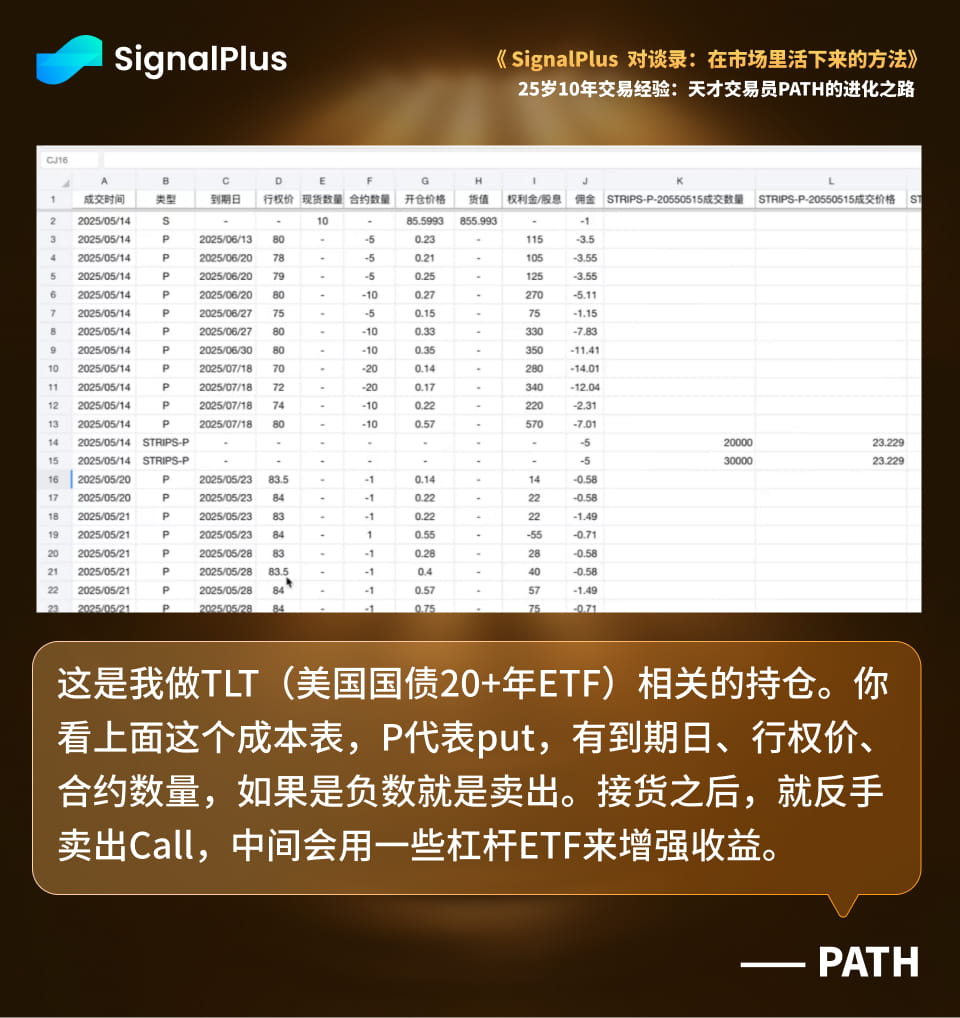
I have a subjective view: the US stock market is in a period of interest rate cuts, and long-term bonds have significant room for appreciation during such periods. I subjectively anticipate a bull market, so how can I match this expectation? My chosen strategy is a cost-based approach, specifically using covered and reverse covered calls with options to reduce costs. Furthermore, the US stock market offers a wide range of instruments, including zero-coupon bonds and leveraged and inverse ETFs, all of which can be helpful in supporting this strategy.
The overall idea is to first establish a base position (equivalent to a ballast stone). I will first hold a certain amount of TLT spot position, rather than selling all Puts at the beginning to take on the goods.
Looking at the cost table above, P stands for put, which includes the expiration date, strike price, and contract quantity. If it's a negative number, it means sell. After receiving the contract, the call is sold, and some leveraged ETFs (LETFs) are used to enhance returns.
LETFs are a favorite trading instrument of mine. One characteristic of them is their tendency to lose money in volatile markets. Bonds are typically subject to significant volatility, so bond LETFs tend to favor volatility losses over trend excess. Since they're losing money, I'll try to short them.
For example, TMF is a triple-long TLT ETF, while TMV is a triple-short TLT ETF. Since I want to short losses while also going long on bonds, I'd choose to short TMV. Specifically, I sell TMV calls and buy TMV puts, balancing them into a negative cost combination. This way, even if the underlying price doesn't move after expiration, I'll still receive a positive premium, making this a good trade. With a negative cost, the upper bound on returns is quite high.
SignalPlus: I see the quantity in your spreadsheet is negative five, which represents the seller, or obligated party, in brokerage software. You are very familiar with this format.
Path: Yes. Once you have your trading history, you can calculate the sum of premiums plus dividends, commissions, spot volume, and total costs, ultimately yielding the average cost. Speaking of which, why did I choose TLT for this strategy? TLT is a collection of bonds, which can be equated to a single large bond. The same pricing methods that apply to bonds also apply to TLT. Bonds have a very good property: a price always corresponds to a yield.
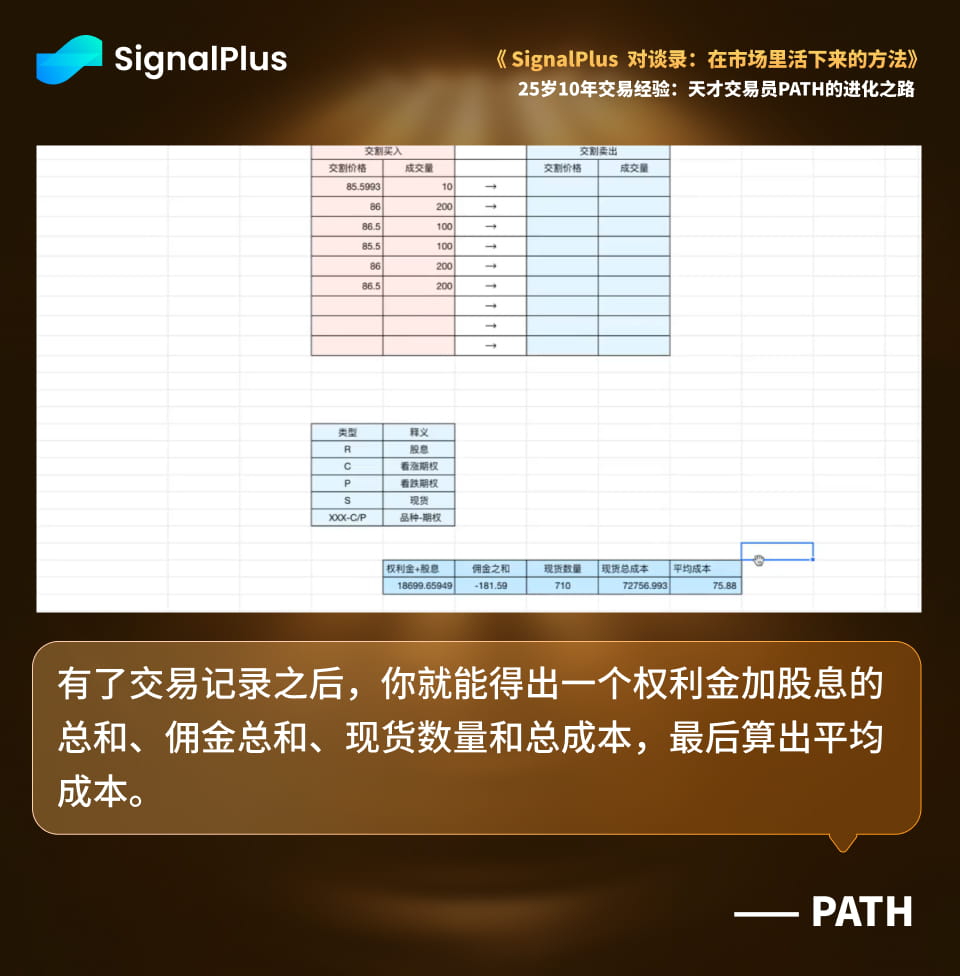
When traders quote bond prices in American business dramas, they often don't quote the strike price, but rather the yield. For example, they might say, "I want to buy a bond worth X amount of money and with a maturity of X years at a price of 5% (here, the 5% yield is simply referred to as the 5% price). Why? Because there's a one-to-one correspondence between price and yield. TLT, as a large bond, also has this property.
Let's say I want to buy TLT at $85. 85 is an abstract concept to me, but if I want to buy it at a 5.09% yield, the concept becomes immediately intuitive. TLT has a duration of approximately 26 years. Am I willing to lock in 26 years at a 5.09% yield? If I think it's a good deal, I'll take it. If it rises to $92, corresponding to a 4.59% yield, I'll decide it's not worth it and sell some. In this way, your holding cost is also a price, and this price also corresponds to a yield. I conservatively estimate that the yield corresponding to my current holding cost is over 8%.
Lowering your costs means your yields are increasing. If I think it's appropriate to hold bonds with maturities of 25 years or more at a cost of over 8%, I'll continue to maintain that cost price.
This cost actually has meaning, and the same applies to stocks. My other account mainly trades Occidental Petroleum (OXY). One of its indicators is the price-to-earnings ratio (PE), which represents your payback period. When your costs are lower, your payback period becomes faster.
In addition, I also perform some cost management on IBIT (BlackRock Bitcoin Spot ETF). There's a correlation between the price of IBIT and the price of Bitcoin: $50 in IBIT corresponds to $87,912 in Bitcoin. While the strike price often seems abstract, establishing this correlation makes it intuitive. Similarly, there's a conversion relationship between the number of shares held and the corresponding amount of coins. I also consolidate the strategies of related underlying assets. For example, if I use a 2x leveraged ETF for an enhanced strategy, I incorporate the profits into IBIT's cost table, reducing IBIT's costs over time. This is how I operate for virtually every underlying asset.
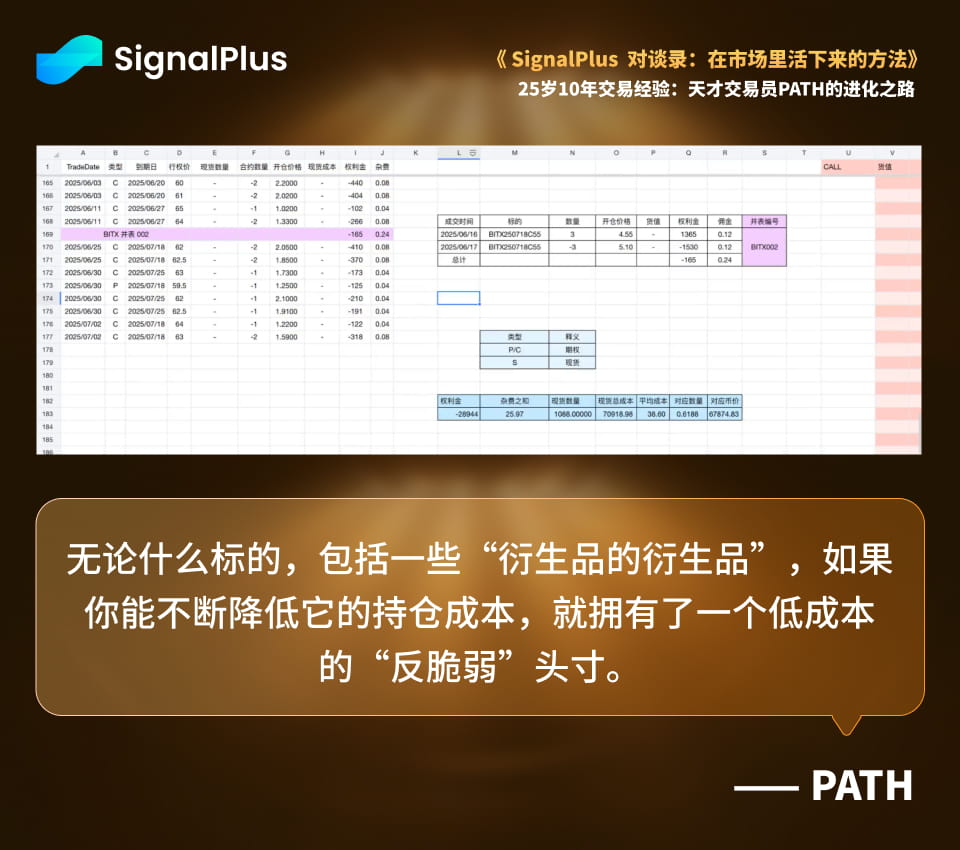
SignalPlus: With your approach, trading seems to have become as simple as "buy low and sell high, you will make money as long as the cost is low enough."
Path: No matter what the target is, including some "derivatives of derivatives", if you can continuously reduce its holding cost, you will have a low-cost "anti-fragile" position.
Everyone understands that holding some "black swan insurance" (antifragile positions) is a good thing, but precisely because everyone wants it, it's usually expensive. If you buy this insurance at a high price, once the market really plummets and the insurance starts to work, your returns will have to be deducted from the high initial cost, so the net profit may not be very high.
Therefore, the key is to hold an anti-fragile position at a low cost. By constantly "scaling" the holding cost down, this position can truly generate significant profits in the future. Take the UVIX (an ETF that trades 2x long on VIX volatility futures) as an example. If you can minimize the cost of holding UVIX, then when the market crashes, it will skyrocket. Your gains, minus the minimal cost, will result in a substantial net return.
Application of low-cost "anti-fragile" strategies in the crypto market
SignalPlus: Is the "low-cost anti-fragility + cash flow" strategy you use in the stock market also applicable in the crypto market?
Path: Crypto doesn't have many volatility derivatives, aside from DVOL futures. But you can construct them yourself. For example, I've used a method before: going long (or going long) on out-of-the-money (OTM) options. Deribit only trades options out to one year, which isn't too far out, but the convexity (the nonlinear acceleration of the option value relative to the underlying asset price, also known as the gamma effect) is sufficient. Then, you continuously buy OTMs in the long term, and use the cash flows from covered and uncovered calls to cover your long-term expenses. This account must balance, because the short-term theta (time value) decays much faster than the long-term. You use the difference in the short-term theta decay to cover your long-term expenses. Repeat this process, and at some point, your OTM position will be free. A free OTM put is like a free lottery ticket—very meaningful.
Specifically, once you've truly won the lottery (i.e., when the forward put option goes in-the-money, triggering a major market crash), my latest strategy is to roll. For example, when BTC rallied recently, I sold my already ITM (in-the-money) call options and opened one with a higher strike price. For example, I sold my position at 40 and opened one at 43. This way, your transaction price is cheaper, meaning you're taking profit. However, while taking profit, you still maintain the convexity of the underlying asset, effectively taking a partial profit, and then continue to roll it back up. This way, the cost of your convexity becomes very low.
SignalPlus: It sounds a lot like a calendar spread strategy. For example, selling the near-month contract and buying the far-month contract, profiting from the difference in theta between the near-month contract and the far-month contract.
Path: It's a calendar structure you construct. Distant time is ticking away, which is unfavorable to you; near time is also ticking away, but it's favorable to you (because you're selling). Near time flows very quickly, so you can constantly use near time to fill in the gaps between distant and distant time.
SignalPlus: You mentioned earlier that you made a significant profit in the crypto market last August through a Black Swan position. Could you elaborate on how you designed this Black Swan position?
Path: At that time (starting in July), I had actually started doing some covered calls and reverse calls, not just holding the coins.
At the time, the BTC price was around $70,000, having already fallen once. When it started to rise again, I started buying OTM puts, buying as the price went up. I bought quite a lot at the time, but I was confident that the short-term cash flow would cover the long-term expenses. I was certain I would recoup my investment; it was something I could recover.
Advice for beginners: The devil is in the details
SignalPlus: You officially entered the crypto market last year and started using SignalPlus. Can you share which features have been most helpful to you?
Path: The risk matrix is my most frequently used tool. Lately, I've been working on some BTC strategies, and it's something I use almost every time I open my account. I look at my profit and loss chart to see how different Greeks affect my profit and loss under certain circumstances. Most importantly, the margin stress test gives me a rough estimate, which is helpful for anticipating future market trends.
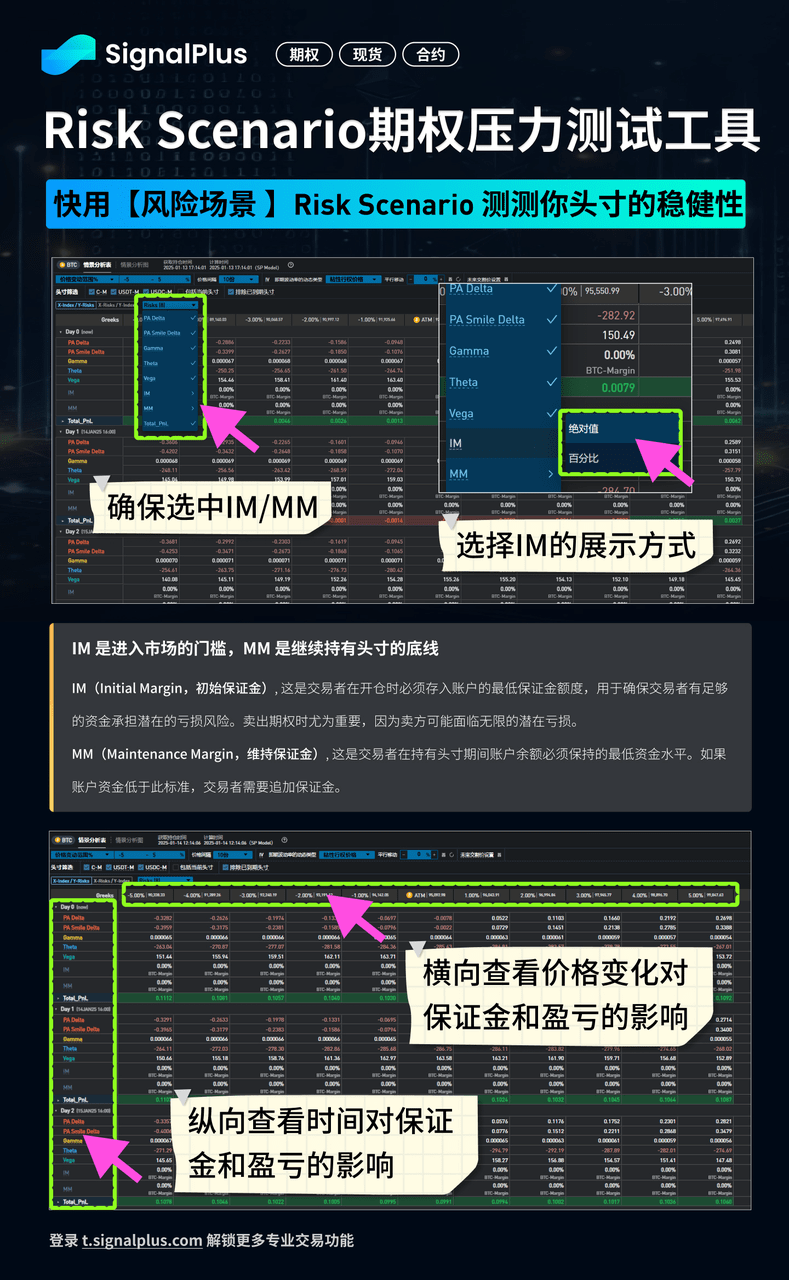
SignalPlus: For those novice investors who used to trade US stock spot or US stock options and are now switching to the Crypto options market, what advice would you like to give, or what do you think are the common pitfalls?
Path: You must fully understand the trading rules for the instruments you're trading. Derivatives have settlement and delivery rules. When exactly is settlement? How is the price calculated? Where does the data come from? You should at least understand these things. I recently saw a case where someone was forced to close out their position despite making a profit because they didn't understand the forced liquidation rules. These things should be disclosed to you in advance; you shouldn't find out after something goes wrong.
Some derivatives in the cryptocurrency market can be a bit more complex. For example, a coin-margined contract, also known as an inverse contract, uses an inverse calculation. For example, if I buy 100 shares of Nvidia in the US stock market, the market value is the transaction price multiplied by 100 shares, expressed in US dollars. However, with an inverse contract, the unit is US dollars, and the market value is the coin itself. I recently even wrote a calculator that visually demonstrates the difference in profit and loss curves between this type of contract and a more common linear contract (which is more advantageous for short-selling investors).
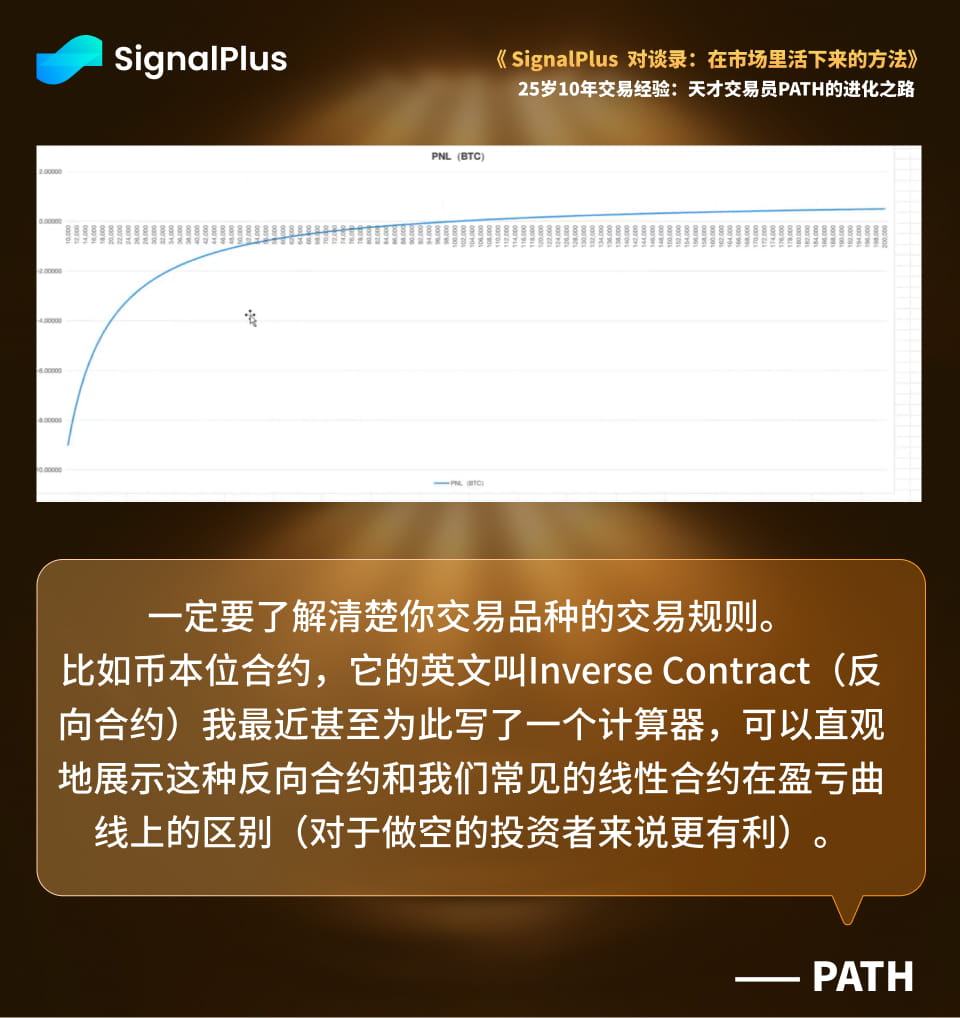
Even at a more basic level, I recommend understanding what Bitcoin (BTC) is. I know many people crudely define BTC as a Ponzi scheme used for money laundering. Have you ever read the BTC whitepaper, examined its source code, replicated it yourself, and experienced it? At the very least, check out a blockchain explorer to see the transactions in each block, the transfers between addresses, and what terms like input and output actually mean.
You should also understand the underlying structure of your trading targets, including Bitcoin, Ethereum, and some aspects of US stocks. For stocks, this involves the underlying financial data (financial reports). Tools like GPT are very advanced now. When I look at financial reports, I first give them the analysis I need—business segments, each segment's share, annual net profit, revenue share by region, and so on. I can now complete research on a stock in a single day, whereas it used to take me months.
SignalPlus: To sum up, you still have to start with the rules and underlying details to fully understand the markets and assets you are trading.
Path: There's a saying that's quite fitting: The devil is in the details. Many things, especially life-threatening ones, are often hidden in these details, so you must pay attention.
Many tools on the SignalPlus platform can also be used to study their data sources and principles. Delta on your platform has both currency-based and dollar-based deltas. You can switch between them to experience the effects of the curves in different units of measurement.
Final advice: Don’t deify the tool, but improve the fault tolerance rate
SignalPlus: Finally, is there anything else you would like to say to our new listeners? Feel free to share your thoughts.
Path: Let's go back to the beginning: You must survive. You must at least survive in this market to have a chance at instant wealth. I've heard many people tell me that they have limited capital and can only take a gamble, using high leverage. But that's not true; it's just your excuse. Whether you hold a 1 million yuan position, a 10 million yuan position, or a 100 million yuan position, you should approach it with the same steady and cautious approach.
Capital accumulation is a process. If you don't diligently persevere, how can one million yuan turn into ten million? So don't rush. First, ensure you stay relevant in the market. Only then will the "ergodic nature" of wealth arrive. You can't wait until your predictions materialize, only to be gone by then. What's the point? So, at least stay alive until that day arrives.
Options trading tools can only provide you with a greater margin for error and a smoother trading curve. They're not a panacea; learning about options won't rocket you to riches. They're simply a tool. Don't deify it; leverage it effectively to increase your margin for error. While others may die, you're still alive.
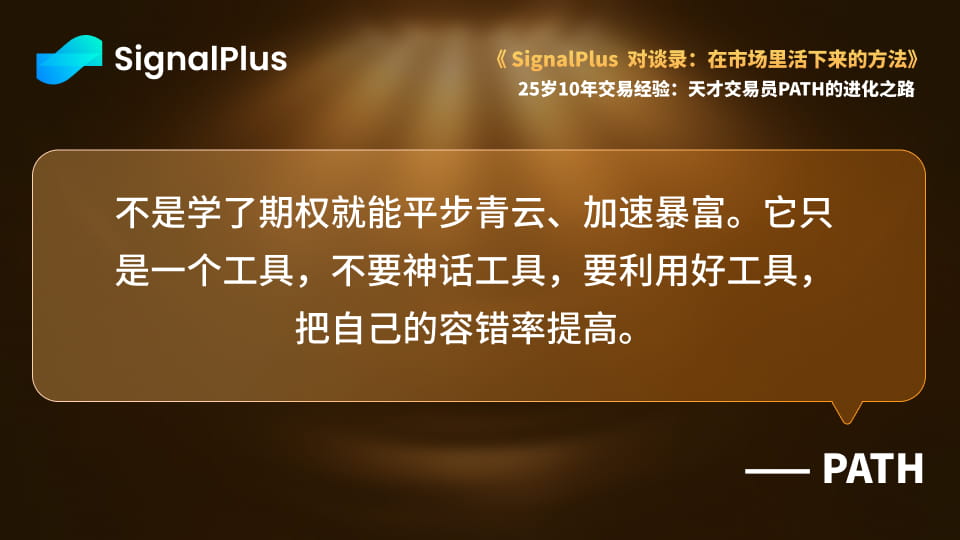
Take the cost of bonds as an example. My current cost corresponds to an 8% return, while the market quote is 5%. Then, when the market falls to the 8% return, those with high costs will inevitably fail before me. The same is true for stocks: companies with higher valuations, poorer asset quality, and greater leverage will inevitably go bankrupt first.
How can you lower your cost? Take Bitcoin, for example. If you can lower the cost of holding the coin to less than the electricity cost of the miners, and you're still alive when they're about to shut down, then you're awesome. If the cost is negative, that's even better.
This is another approach: using derivatives like options to continuously reduce holding costs. Options have a great advantage: they allow you to trade risks beyond the current price. If Bitcoin is currently trading at $100,000, you can trade exposure to $90,000 or even $80,000. Linear products won't work that way. You can leverage this property to continuously reduce your costs. Even if some claim Bitcoin has no cash flow, you can use options to create it, manually realizing its cash flow.
Path's ten years have been an epic story about systematic survival in an ever-changing market. We believe that equally exciting stories lie hidden in every corner of the market.
(SignalPlus Conversation: How to Survive in the Market) We are looking for experienced investors like you.
If you're a seasoned investor with over $100,000 in assets under management, we sincerely invite you to participate in a one-on-one in-depth interview. We're eager to learn about your unique investment style and winning strategies, and are willing to invest our professional resources to organize your valuable experience into in-depth articles and share them with the entire community.
Your success deserves to be seen. We look forward to hearing from you!
